NSTITUT SUPERIEUR D'ANTHROPOLOGIE
INSTITUTE OF ANTHROPOLOGY
ONLINE COURSES / COURS A DISTANCE
WINTER TERM : JANUARY 2014
REGISTER NOW
AZERBAIDJAN –  Shakhtakhti - Today the head of the Shahtakhti archaeological expedition, Gahraman Agayev said that in 2014 the Institute of Archaeology and Ethnography of the National Academy of Sciences of Azerbaijan will address the Cabinet of Ministers with an initiative to open an open air museum at the site of the ancient Shakhtakhti archaeological complex in the Nakhichevan Autonomous Republic.Research conducted this year shows that this ancient site is 6500-7000 years old.Agayev stressed that this archaeological site was the only inhabited place of the Eneolithic Era, that is in the copper-stone age, not only in Azerbaijan but also in the Caucasus and in the Middle East.
Shakhtakhti - Today the head of the Shahtakhti archaeological expedition, Gahraman Agayev said that in 2014 the Institute of Archaeology and Ethnography of the National Academy of Sciences of Azerbaijan will address the Cabinet of Ministers with an initiative to open an open air museum at the site of the ancient Shakhtakhti archaeological complex in the Nakhichevan Autonomous Republic.Research conducted this year shows that this ancient site is 6500-7000 years old.Agayev stressed that this archaeological site was the only inhabited place of the Eneolithic Era, that is in the copper-stone age, not only in Azerbaijan but also in the Caucasus and in the Middle East.
http://vestnikkavkaza.net/news/culture/49261.html
USA - Bayou Teche - Fieldwork could begin as early as June on an archaeology project to find some of the earliest settlements of the Acadian exiles who made their way to Louisiana. The current focus is along Bayou Teche near Loreauville in Iberia Parish, where Cajun folk hero Joseph “Beausoleil” Broussard helped lead a group in 1765 after unsuccessfully battling British efforts to remove the French Acadians from what is now Nova Scotia. More than 30 of them died within months of their arrival, likely from disease, leaving few clues about where or how they lived or even where they were buried. “Very little is known about them. We don’t know what kind of material culture they brought with them,” said Mark Rees, a University of Louisiana at Lafayette archaeologist and anthropologist.
http://theadvocate.com/home/7924148-125/archaeologists-search-bayou-teche-for
INDE - Midnapore - A gold locket and a mixed metal coin belonging to the 5th-6th century AD were found during excavations at Dantan area of West Midnapur district, police said today. The artefacts were found yesterday morning at Mogolmari village, the site of an ancient Buddhist vihara during excavations by the state archaeology department. The locket had little designs on it, while the coin has inscriptions in Brahmi script and the figure of a warrior on one side and that of a goddess, probably Goddess Lakshmi, on another. The artefacts have been sent to Kolkata for further studies, police said. Excavations were launched in the area about a decade ago at the behest of the archaeology department of Calcutta University and remains of a Buddhist vihara belonging to the 5th century AD had been found. The present excavations are continuation of the work. Two small Buddha images belonging to the 5th-6th century AD were found from the site recently. The vihara is believed to be the one mentioned by Chinese travellers Fa Hien and Huen Tsang in their writings. Fa Hien had visited the country during the reign of Gupta period Emperor Chandragupta Vikramaditya and stayed in Tamralipta, several kilometres away from Mogolmari. Dantan fell on the way to the ancient sea port of Tamralipta.
http://zeenews.india.com/news/west-bengal/ancient-artefacts-found-during-excavation-in-midnapore_897924.html
ISRAËL – 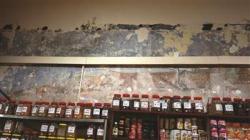 Haifa - Locals in Haifa have discovered a large painting dating back from World War I in a nuts store in the coastal Israeli city. The 10-meter-wide and three-meter-high painting, which covers the entire wall, depicts an air attack by the British army against the Ottoman army during World War I. After a long and detailed work, the painting by an Ottoman soldier was finally revealed. Dozens of miniatures depicting Turkish warplanes bombing British planes or dead and wounded Turkish soldiers being carried on stretchers were found. Below the painting was the signature of the painter, “Edip Kemal,” and the words “Hotel Zahara Syria.” Speaking about the issue, Liran said: “We have examined a Hebrew newspaper from this era and found out that Edip Kemal was an Ottoman officer of Transcaucasian origin. He went to Damascus with the Ottoman army, which lost the war and withdrew to Damascus, but he returned to Jerusalem in 1933 and then to Haifa. He operated this nuts store as a boxing club. We couldn’t really understand why he used the expression ‘Hotel Zahara Syria.’ But then we realized that the building was used as a hotel in this era and it was a branch of the Hotel Zahara chain. We saw that the pictures of the hotel in Damascus and this building were exactly the same.” Haifa was a port city where the Ottoman army set up a base for sea transportation until the end of World War I. After the war, the region was mentioned as a “Turkish region” by locals. Later on, the barracks of the Turkish army and other structures were demolished systematically to remove the traces of Turks in the region.
Haifa - Locals in Haifa have discovered a large painting dating back from World War I in a nuts store in the coastal Israeli city. The 10-meter-wide and three-meter-high painting, which covers the entire wall, depicts an air attack by the British army against the Ottoman army during World War I. After a long and detailed work, the painting by an Ottoman soldier was finally revealed. Dozens of miniatures depicting Turkish warplanes bombing British planes or dead and wounded Turkish soldiers being carried on stretchers were found. Below the painting was the signature of the painter, “Edip Kemal,” and the words “Hotel Zahara Syria.” Speaking about the issue, Liran said: “We have examined a Hebrew newspaper from this era and found out that Edip Kemal was an Ottoman officer of Transcaucasian origin. He went to Damascus with the Ottoman army, which lost the war and withdrew to Damascus, but he returned to Jerusalem in 1933 and then to Haifa. He operated this nuts store as a boxing club. We couldn’t really understand why he used the expression ‘Hotel Zahara Syria.’ But then we realized that the building was used as a hotel in this era and it was a branch of the Hotel Zahara chain. We saw that the pictures of the hotel in Damascus and this building were exactly the same.” Haifa was a port city where the Ottoman army set up a base for sea transportation until the end of World War I. After the war, the region was mentioned as a “Turkish region” by locals. Later on, the barracks of the Turkish army and other structures were demolished systematically to remove the traces of Turks in the region.
http://www.hurriyetdailynews.com/wall-painting-by-ottoman-officer-found-in-haifa.aspx?pageID=238&nID=60024&NewsCatID=375
EQUATEUR – 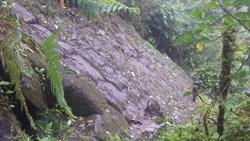 Llanganates - Aerial Digital Archeology & Preservation (A.D.A.P), a non-invasive technology research group, has been exploring a mysterious rock structure discovered in the remote area of the Llanganates, a region famous for its connections with Inca legends. The site could belong to an ancient culture, be the emerged part of a buried pyramid, the lost tomb of the most famous Inca ruler or a unique natural formation.It is in this area where that the Inca general Ruminahui was born. He led the Inca resistance in actual Ecuador until the Spaniards captured him. Since that time, the Llanganates region has been associated with historical facts and bold legends. Before the arrival of the Spaniards, the Inca general would have most likely hidden the mummified body of the emperor Atahualpa somewhere in these mysterious mountains. An expedition composed by licensed archaeologists and paleontologists will apparently be launched soon to carry out an initial assessment of the archaeological potential of the site. Later on, a second expedition will be be organized with the participation different experts in order to fully survey the site and its surroundings.
Llanganates - Aerial Digital Archeology & Preservation (A.D.A.P), a non-invasive technology research group, has been exploring a mysterious rock structure discovered in the remote area of the Llanganates, a region famous for its connections with Inca legends. The site could belong to an ancient culture, be the emerged part of a buried pyramid, the lost tomb of the most famous Inca ruler or a unique natural formation.It is in this area where that the Inca general Ruminahui was born. He led the Inca resistance in actual Ecuador until the Spaniards captured him. Since that time, the Llanganates region has been associated with historical facts and bold legends. Before the arrival of the Spaniards, the Inca general would have most likely hidden the mummified body of the emperor Atahualpa somewhere in these mysterious mountains. An expedition composed by licensed archaeologists and paleontologists will apparently be launched soon to carry out an initial assessment of the archaeological potential of the site. Later on, a second expedition will be be organized with the participation different experts in order to fully survey the site and its surroundings.
http://www.prweb.com/releases/dronearchaeology/llanganates/prweb11437760.htm
USA – 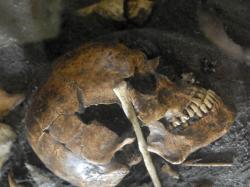 Windover - Tucked behind a leafy oak hammock near this Brevard County city, a murky blackwater bog containing some of the world's rarest archaeological treasures will remain protected from a potential housing development. The vegetated 8.5-acre upland buffer bordering the Windover Archaeological Site has been purchased for $90,000 by The Archaeological Conservancy. A backhoe operator stumbled upon the prehistoric burial ground in 1982. Since then, scientists have excavated 168 remarkably preserved skeletons dating to the Early Archaic period from Windover's swamp — including some of the oldest brain DNA samples ever found on the planet. Radiocarbon dating of these bones goes back as far back as 8,120 years. Windover's prehistoric inhabitants may have descended from the Asian migrants who crossed the Bering land bridge into North America during the last Ice Age. Excavation at the Windover Archaeological Site occurred from 1984-86. Scientists unearthed semi-domesticated plants; the skeleton of a boy with spina bifida who lived to about age 15; and some of the Western Hemisphere's oldest textile fabrics. These discoveries forced archaeologists to revise their theories of North America's early inhabitants, who were thought to be nomadic hunter-gatherers. Key finds included 91 skulls containing brain tissue; hammers fashioned from manatee ribs; and knives and scrapers made using shark and wolf teeth.
Windover - Tucked behind a leafy oak hammock near this Brevard County city, a murky blackwater bog containing some of the world's rarest archaeological treasures will remain protected from a potential housing development. The vegetated 8.5-acre upland buffer bordering the Windover Archaeological Site has been purchased for $90,000 by The Archaeological Conservancy. A backhoe operator stumbled upon the prehistoric burial ground in 1982. Since then, scientists have excavated 168 remarkably preserved skeletons dating to the Early Archaic period from Windover's swamp — including some of the oldest brain DNA samples ever found on the planet. Radiocarbon dating of these bones goes back as far back as 8,120 years. Windover's prehistoric inhabitants may have descended from the Asian migrants who crossed the Bering land bridge into North America during the last Ice Age. Excavation at the Windover Archaeological Site occurred from 1984-86. Scientists unearthed semi-domesticated plants; the skeleton of a boy with spina bifida who lived to about age 15; and some of the Western Hemisphere's oldest textile fabrics. These discoveries forced archaeologists to revise their theories of North America's early inhabitants, who were thought to be nomadic hunter-gatherers. Key finds included 91 skulls containing brain tissue; hammers fashioned from manatee ribs; and knives and scrapers made using shark and wolf teeth.
http://www.usatoday.com/story/news/nation/2013/12/23/windover-bog/4146659/
ROYAUME UNI – 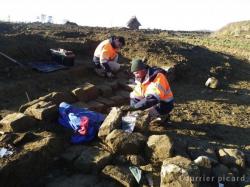
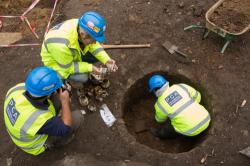 Londres - Roman burials have been found at an archaeological dig taking place in Dickens Square as part of the preparations for the building of an extension to the Harper Road mosque. This week the first Roman burials were found on the site – a discovery that did not come as a great surprise given that burials dated from the 1st to the 4th century have been discovered in recent years at digs in Trinity Street, Deverell Street and other sites in and around Harper Road. Earlier in the month, excavation of the upper levels of the site had revealed three adult cattle skeletons dating to the late 1800s which archaeologists believe are related to the rinderpest pandemics which affected Britain in the 18th century. Two wells gave have been revealed on the Dickens Square site, one of which contains a number of ceramic items such as cups and tableware from the late 1800s.
Londres - Roman burials have been found at an archaeological dig taking place in Dickens Square as part of the preparations for the building of an extension to the Harper Road mosque. This week the first Roman burials were found on the site – a discovery that did not come as a great surprise given that burials dated from the 1st to the 4th century have been discovered in recent years at digs in Trinity Street, Deverell Street and other sites in and around Harper Road. Earlier in the month, excavation of the upper levels of the site had revealed three adult cattle skeletons dating to the late 1800s which archaeologists believe are related to the rinderpest pandemics which affected Britain in the 18th century. Two wells gave have been revealed on the Dickens Square site, one of which contains a number of ceramic items such as cups and tableware from the late 1800s.
http://www.london-se1.co.uk/news/view/7298
EGYPTE – 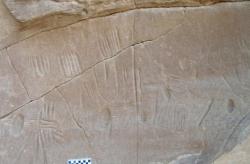 Kharga - Archaeologists have discovered a panel containing the only known example of spider rock art in Egypt and, it appears, the entire Old World. The rock panel, now in two pieces, was found on the west wall of a shallow sandstone wadi, or valley, in the Kharga Oasis, located in Egypt's western desert about 108 miles (175 kilometers) west of Luxor.Even so, based on other activity in the area, the rock art may date to about 4000 B.C. or earlier, which would put it well into prehistoric times, before Egypt was unified, noted Ikram, who detailed the finding in the most recent edition of the journal Sahara.
Kharga - Archaeologists have discovered a panel containing the only known example of spider rock art in Egypt and, it appears, the entire Old World. The rock panel, now in two pieces, was found on the west wall of a shallow sandstone wadi, or valley, in the Kharga Oasis, located in Egypt's western desert about 108 miles (175 kilometers) west of Luxor.Even so, based on other activity in the area, the rock art may date to about 4000 B.C. or earlier, which would put it well into prehistoric times, before Egypt was unified, noted Ikram, who detailed the finding in the most recent edition of the journal Sahara.
http://www.livescience.com/42126-spider-rock-art-discovered-in-egypt.html